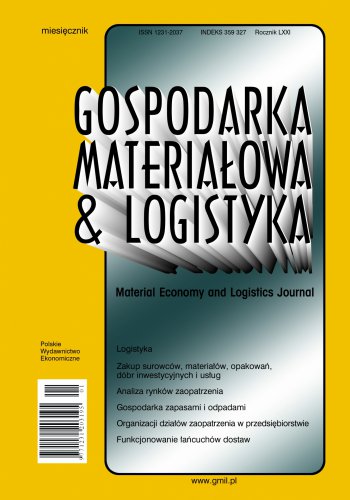Dynamics of forming the network relationships in a supply chain. The triadic perspective
One of the key prerequisites for establishing the network connections in a supply chain is the focus of primary members on core competencies and outsourcing remaining services to the service providers. As a result, the multiple relationships with several actors are established. In the literature, to illustrate the network relationships in a supply chain, the concept of transitive triads has been often employed. Nonetheless, this framework is rather static, as it does not derive the real dynamics of forming the network relationship in the light of the social capital theory for which the concept of triad is a key issue. The paper aims to reveal and describe the stages of forming the network relationships in a supply chain with the use of transitive service triad. The transitive triad encompasses three actors that establish the dyadic relationships between one another. As a result, the transitive triad is formed by three dyadic arrangements.
References
Bibliografia/References
Achrol, R. S. (1997). Changes in the theory of interorganizational relations in marketing: towards a network paradigm. Journal of the Academy of Marketing Science, 25(1), 56–71. https://doi.org/10.1007/bf02894509
Ballou, R. H. (2004). Business Logistics/ Supply Chain Management. 5th ed. New Jersey: Prentice Hall.
Barratt, M. (2004). Understanding the meaning of collaboration in the supply chain, Supply Chain Management: An International Journal, 9(1), 30–42. https://doi.org/10.1108/13598540410517566
Burt, R. S. (2017). Structural holes versus network closure as social capital. New York: Routledge.
Chae, S. (2018). Horizontal versus vertical structural holes in supply networks: Contrasting performance implications for focal firms, Proceedings of the 20th EurOMA Conference, 24–26 June, Budapest.
Choi, T. Y., Wu, Z. (2009a): Triads in supply networks: theorizing buyer-supplier-supplier relationships. Journal of Supply Chain Management, 45(1), 8–25. https://doi.org/10.1111/j.1745-493x.2009.03151.x
Choi, T. Y., Wu, Z. (2009b). Taking the leap from dyads to triads: buyer-supplier relationships in supply networks. Journal of Purchasing and Supply Management, 15(4), 263–266. https://doi.org/10.1016/j.pursup.2009.08.003
Coleman, J. (1990). Foundations of social theory. Cambridge: Harvard University Press.
Dubois, A. (2009). Comment on "Taking the leap from dyads to triads: buyer-supplier relationships in supply networks" by Choi and Wu — To leap or not to leap: triads as arbitrary subsets of networks of connected dyads. Journal of Purchasing & Supply Management, 15, 267–268. https://doi.org/10.1016/j.pursup.2009.08.003
Finne, M., Holmström J. (2013). A manufacturer moving upstream: triadic collaboration for service delivery. Supply Chain Management: An International Journal, 18(1), 21–33. https://doi.org/10.1108/13598541311293159
Hirschheim, R., Lacity, M. (2000). The Myths and Realities of Information Technology Insourcing. Communications of the ACM, 43(2), 99–107. https://doi.org/10.1145/328236.328112
Karatzas, A., Johnson, M., Bastl, M. (2017). Manufacturer–supplier relationships and service performance in service triads. International Journal of Operations & Production Management, 37(7), 950–969. https://doi.org/10.1108/ijopm-11-2015-0719
Krackhardt, D. (1999). The ties that torture: simmelian tie analysis in organizations. Research in the Sociology of Organizations, 16(1), 183–210.
Li, M., Choi, T. Y. (2009). Triads in service outsourcing: bridge, bridge decay and bridge transfer. Journal of Supply Chain Management, 45(3), 27–39. https://doi.org/10.1111/j.1745-493x.2009.03169.x
Liker, J., Choi, T. (2004). Building Deep Supplier Relationships. Harvard Business Review, 82(12), 104–113.
Madhavan, R., Gnyawali, D., He, J. (2004). Two's company, three's a crowd? Triads in cooperative-competitive networks. Academy of Management Journal, 47(6), 918–927. https://doi.org/10.5465/20159631
Mentzer, J. T., Stank, T. P., Myers, M. B. (2007). Why global supply chain management? Global Supply Chain Management, Thousand Oaks: SAGE Publications. https://doi.org/10.4135/9781412976169.n1
Obstfeld, D. (2005). Social networks, the tertius iungens orientation, and involvement in innovation. Administrative Science Quarterly, 50 (1), 100–130. https://doi.org/10.2189/asqu.2005.50.1.100
Obstfeld, D., Borgatti, S. P., Davis, J. P. (2014). Brokerage as a process: decoupling third party action from social network structure. W: S. P. Borgatti, D. J. Brass, D. S. Halgin, G. Labianca, A. Mehra (red.), Contemporary perspectives on organizational social networks. Cambridge: Emerald. https://doi.org/10.1108/s0733-558x(2014)0000040007
Portier, P. Pardo, C., Salle, R. (2014). From dyad to triad: managing differentiated vs. undifferentiated relationships, 30th IMP Conference, Bordeaux.
Sampson, S. (2000). Customer-supplier duality and bi-directional supply chains in service organizations. International Journal of Service Industry Management, 11(4), 348–364. https://doi.org/10.1108/09564230010355377
Schreiner, A. (2015). Triadic analysis of business relationship's ending: a case study of a dyad and a third actor. Journal of Business & Industrial Marketing, 30(8), 891–905. https://doi.org/10.1108/jbim-01-2014-0023
Simmel, G. (1950). The sociology of Georg Simmel. New York: Free Press.
Świerczek, A. (2005). Elektroniczne łańcuchy dostaw. Gospodarka Materiałowa i Logistyka, (4), 6–12.
Świerczek, A. (2006). Znaczenie sieci informacyjnej w kształtowaniu organizacji sieciowej. Gospodarka Materiałowa i Logistyka, (6), 16–22.
Świerczek, A. (2012). Zarządzanie ryzykiem transmisji zakłóceń we współdziałaniu przedsiębiorstw w łańcuchach dostaw. Katowice: UE w Katowicach.
Świerczek, A. (2019a). Zarządzanie łańcuchem dostaw w ujęciu zintegrowanym. Warszawa: PWE.
Świerczek, A. (2019b). Manufacturer structural embeddedness and the network rent: the intervening role of relational embeddedness in the triadic supply chains. Supply Chain Management: An International Journal, 24(3), 334–354. https://doi.org/10.1108/scm-06-2018-0232
Świerczek, A. (2020a). Rezylientne łańcuchy dostaw jako złożone systemy adaptacyjne. Warszawa: PWE.
Świerczek, A. (2020b). Relational orientation of triadic supply chains with structural holes: an empirical comparison of rents derived from bridging the structural holes. Supply Chain Management: An International Journal, 25(5), 565–583. https://doi.org/10.1108/scm-10-2019-0382
Świerczek, A. (2020c). Conceptualizing the role of embeddedness in deriving the network competitive advantage of triadic supply chains. Gospodarka Materiałowa i Logistyka, (1), 2–10. https://doi.org/10.33226/1231-2037.2020.1.1
Wynstra, F., Spring, M., Schoenherr, T. (2015). Service triads: a research agenda for buyer-supplier-customer triads in business services, Journal of Operations Management, 35, 1–20. https://doi.org/10.1016/j.jom.2014.10.002
Zhang, J. J., Lawrence, B., Anderson, C. K. (2015). An agency perspective on service triads: linking operational and financial performance, Journal of Operations Management, 35(3), 56–66. https://doi.org/10.1016/j.jom.2014.10.005

